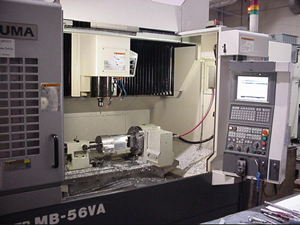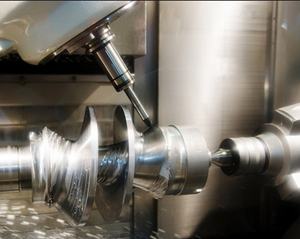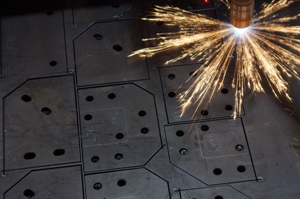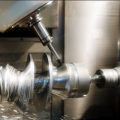 The manufacturing sector relies heavily on CNC machining as a part of their automated production lines. CNC machining is a computer- controlled process used to control machine tools. CNC machining is a more sophisticated version of computer control because it utilizes unique software in combination with a console control panel to control a variety of machines including lathes, mills, routers, drills and grinders.
The manufacturing sector relies heavily on CNC machining as a part of their automated production lines. CNC machining is a computer- controlled process used to control machine tools. CNC machining is a more sophisticated version of computer control because it utilizes unique software in combination with a console control panel to control a variety of machines including lathes, mills, routers, drills and grinders.
Machine tools work by numerical control under CNC machining. A customized software program is created for each object that will be manufactured. The machines are then programmed using CNC machining language or G –code. This code controls many different aspects of the work to be done including the material feed rate, positioning and speed or velocity. CNC machining is utilized on both metals and plastics in the manufacturing sector.
Process
The first step in CNC machining is to create a 2D or 3D CAD drawing of the object including its shape and all measurements. Next, a programmer creates the machining code. An operator loads the program and runs a test to make certain there are no problems with the code.
The program is run without material. This step is referred to as “cutting air” and it is a crucial step in the process to ensure the tool position and speed are absolutely correct. Any mistake can result in damage to the machine, or to the part.
Benefits
 CNC machining has several benefits over manual machining. The process is much more precise than manual machining, and once the program is loaded and tested it can repeat the process precisely over and over again, resulting in perfectly manufactured parts that can meet very small tolerances. The resulting parts are identical to one another.
CNC machining has several benefits over manual machining. The process is much more precise than manual machining, and once the program is loaded and tested it can repeat the process precisely over and over again, resulting in perfectly manufactured parts that can meet very small tolerances. The resulting parts are identical to one another.
This process also produces objects much more quickly than manual machining and allows manufacturers to meet high volume orders with ease. Another benefit of CNC machining is that it can produce complex shapes and three-dimensional shapes that are almost impossible to create using manual machining.
Unlike humans that require mandated rest periods throughout the work day, CNC machines can run 24 hours a day, 365 days a year. The only time they need to be turned off is for periodic maintenance, or repair.
The other benefit to using CNC machines is that the engineers or operators of the CNC machines do need as high of a skill level as manual machine engineers and one operator can supervise several machines simultaneously, saving on labor costs.
Repetitive tasks are easily automated and with the precision of CNC machining there is very little waste and significant increases to overall productivity that enables manufacturers to keep their costs low.
CNC MACHINES
CNC Water Jet Cutter
A water jet cutter can slice metal or other materials by utilizing a high velocity water jet and pressure, or a mixture of high velocity water and an abrasive substance like sand. This process is commonly used to produce machinery parts that use materials which are sensitive to high temperatures. Water jet cutters can cut, shape, carve, or ream materials.
CNC Plasma Cutters
 The CNC plasma cutter utilizes a plasma torch. It is most often used to cut steel, but it can also be used on a variety of other materials. The plasma cutting process uses an inert gas like compressed air which is blown out of the nozzle at a very high speed.
The CNC plasma cutter utilizes a plasma torch. It is most often used to cut steel, but it can also be used on a variety of other materials. The plasma cutting process uses an inert gas like compressed air which is blown out of the nozzle at a very high speed.
Simultaneously, an electrical arc is generated through the gas from the nozzle to the surface of the work piece. Some of the gas turns into plasma. The plasma is hot enough to melt the material being cut and moves fast enough to blow the melted metal away from the cut.
CNC Lathes
Lathes cut spinning pieces of metal. CNC lathes can use indexed tools and drills to make fast, precise cuts. The lathes use complicated programs in order to manufacture parts that cannot be produced with a manually controlled lathe. Many lathes use G code or read a manufacturer’s proprietary programming language. CNC lathes often contain up to 12 tool holders and coolant pumps in order to reduce wear and tear on the tools.
CNC Mills
CNC mills work by translating programs that consist of letters and numbers to move the spindle to different depths and locations on the work piece to cut a variety of different materials.
CNC Electric Discharge Machining
This process is often referred to as spark machining. Electric discharges are used to create a desired shape. Material gets removed from a work piece by a series of quickly recurring electric discharges occurring between two electrodes. The electrodes are separated by a dielectric fluid and the discharge is subjected to an electric voltage. One electrode is the “tool” electrode and the other is the “work piece” Electrode.
The electric field in the space between the electrodes grows stronger than the strength of the dielectric when the distance between the two electrodes is reduced. This results in the dielectric breaking and allowing current to flow between the electrodes. When the current flows between the electrodes, material is removed from both of the electrodes.
When the current stops, new dielectric fluid is added into the inter-electrode volume which lets the solid particles be carried away while the insulating properties of the dielectric are restored. This process is referred to as “flushing”.
SUMMARY
The manufacturing industry covers many different applications. Manufacturing can be a highly automated process. The machinery most commonly used in modern production lines and manufacturing companies are CNC machining tools because they can deliver exact copies of an object faster and more accurately than manually controlled machines.
They can also reproduce complicated shapes and forms that cannot be created with manual machining. Their speed and accuracy also reduce labor costs and waste while increasing productivity and efficiency. These things allow manufacturers to keep costs down and meet high volume demands.
